Kichler Lighting 42878NI Manuel utilisateur
- Taper
- Manuel utilisateur

CAP
CACHE
ARM
BRAS
BRACKET
SUPPORT
BALL STUD
GOUJON À BILLE
BALL KNOB
BOUTON À BILLE
GLASS
VERRE
1) Insert recommended bulb.
2) Lower cap down to glass. Fit bulb inside glass.
3) Fit one bracket around indentation in glass. Align holes on
each end of bracket with holes at end of each arm on fixture.
4) Fit second bracket around indentation in glass. Align hole on
each end of bracket with holes at end of each arm on fixture
and holes in first bracket.
5) Slip end of one ball stud through holes in brackets and arm.
6) Thread ball knob onto end of ball stud protruding from hole
in bracket.
7) Repeats steps 5 and 6 for using remaining ball stud and ball
knob.
8) Tighten both ball knobs to secure brackets in place.
9) TURN OFF POWER.
IMPORTANT: Before you start, NEVER attempt any work
without shutting off the electricity until the work is done.
a) Go to the main fuse, or circuit breaker, box in your
home. Place the main power switch in the “OFF”
position.
b) Unscrew the fuse(s), or switch “OFF” the circuit breaker
switch(s), that control the power to the fixture or room
that you are working on.
c) Place the wall switch in the “OFF” position. If the fixture
to be replaced has a switch or pull chain, place those in
the “OFF” position.
10) Assemble mounting screws into threaded holes in mounting
strap.
11) Attach mounting strap to outlet box. (Screws not provided)
12) Slip cord from fixture through bushed hole in canopy. Tie
cord in knot and tighten knot securely.
13) Connect ground wire from fixture and ground wire from
outlet box in outlet box.
14) Make wire connections (connectors not provided.) Reference
chart below for correct connections and wire accordingly.
15) Push fixture to ceiling, carefully passing mounting screws
through holes in canopy.
16) Thread knurl knobs onto mounting screws. Tighten knurl
knobs to secure fixture to ceiling.
1) Introduire l’ampoule recommandée.
2) Abaisser le cache jusqu’au verre. Placer l’ampoule à
l’intérieur du verre.
3) Installer un support autour de l’indentation dans le verre.
Aligner les trous situés sur chaque extrémité du support
avec les trous situés à l’extrémité de chaque bras sur le
luminaire.
4) Installer un autre support autour de l’indentation dans le
verre. Aligner le trou situé sur chaque extrémité du support
avec les trous situés à l’extrémité de chaque bras sur le
luminaire et aux trous dans le premier support.
5) Glisser l’extrémité d’un goujon à bille par les trous situés
dans les supports et le bras.
6) Serrer le bouton à bille sur l’extrémité du goujon à bille
ressortant du trou du support.
7) Répéter les étapes 5 et 6 pour l’autre goujon à bille et
bouton à bille.
8) Serrer les deux goujons à bille pour fixer le support.
9) COUPER LE COURANT.
IMPORTANT: TOUJOURS couper l’électricité avant de
commencer le travail.
a) Localiser le coffret à fusibles ou le disjoncteur du
domicile. Mettre l’interrupteur principal en position
d’Arrêt.
b) Dévisser le ou les fusibles (ou mettre le disjoncteur sur
Arrêt) qui contrôlent l’alimentation vers le luminaire ou la
pièce dans laquelle le travail est effectué.
c) Mettre l’interrupteur mural en position d’Arrêt. Si le luminaire
à remplacer est doté d’un interrupteur ou d’une chaîne
connectée à l‘interrupteur, placer ces éléments en
position d’Arrêt.
Connect Black or
Red Supply Wire to:
Connect
White Supply Wire to:
Black White
*Parallel cord (round & smooth) *Parallel cord (square & ridged)
Clear, Brown, Gold or Black
without tracer
Clear, Brown, Gold or Black
with tracer
Insulated wire (other than green)
with copper conductor
Insulated wire (other than green)
with silver conductor
*Note: When parallel wires (SPT I & SPT II)
are used. The neutral wire is square shaped
or ridged and the other wire will be round in
shape or smooth (see illus.)
Neutral Wire
Date Issued: 8/9/13 IS-42878-CB
INSTRUCTIONS
For Assembling and Installing Fixtures in Canada
Pour L’assemblage et L’installation Au Canada
MOUNTING STRAP
PATTE DE FIXATION
CANOPY
CACHE
KNURL KNOB
BOUTON MOLETÉ
Connecter le fil noir ou
rouge de la boite
Connecter le fil blanc de la boîte
A Noir A Blanc
*Au cordon parallèle (rond et lisse)
*Au cordon parallele (à angles droits el strié)
Au bransparent, doré, marron, ou
noir sans fil distinctif
Au transparent, doré, marron, ou
noir avec un til distinctif
Fil isolé (sauf fil vert) avec
conducteur en cuivre
Fil isolé (sauf fil vert) avec
conducteur en argent
*Remarque: Avec emploi d’un fil paralléle
(SPT I et SPT II). Le fil neutre est á angles
droits ou strié et l’autre fil doit étre rond ou
lisse (Voir le schéma).
Fil Neutre
CORD
CORDON
10) Monter les vis de fixation dans les trous filetés du collier de
fixation.
11) Visser le collier de fixaiton à la boîte de jonction (vis non
fournies).
12) Glisser le cordon du lustre dans la douille de la coupelle.
Faire un noeud dans le cordon et serrer fortement.
13) Brancher le fil de terre du lustre et le fil de terre de la boîte
de jonction dans la boîte de jonction.
14) Effectuer les raccordements électriques (les cosses ne sont
pas founies). Si les fils du lustre ne sont pas noir et blanc,
se reporter au tableau ci-dessous pour effectuer les raccordements
convenables et câbler en conséquence.
15) Appliquer le lustre contre le plafond en faisant passer avec
précautions les vis montage dans les trous de la coupelle.
16) Fixer le lustre au plafond à l’aide de rondelles-freins et des
boutons moletés.
-
 1
1
Kichler Lighting 42878NI Manuel utilisateur
- Taper
- Manuel utilisateur
dans d''autres langues
- English: Kichler Lighting 42878NI User manual
Documents connexes
-
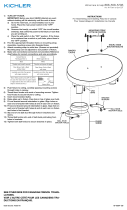 Kichler Lighting 42891NI Manuel utilisateur
Kichler Lighting 42891NI Manuel utilisateur
-
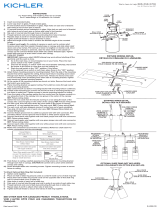 Kichler Lighting 42890NI Manuel utilisateur
Kichler Lighting 42890NI Manuel utilisateur
-
Kichler 45576OZ Manuel utilisateur
-
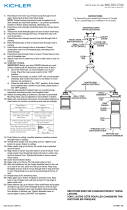 Kichler Lighting 49667WZC Manuel utilisateur
Kichler Lighting 49667WZC Manuel utilisateur
-
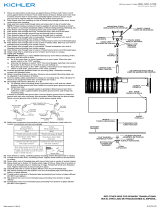 Kichler Lighting 43754AUB Manuel utilisateur
Kichler Lighting 43754AUB Manuel utilisateur
-
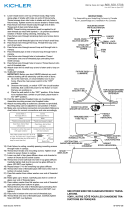 Kichler Lighting 43742NBR Manuel utilisateur
Kichler Lighting 43742NBR Manuel utilisateur
-
 Kichler Lighting 43390NI Manuel utilisateur
Kichler Lighting 43390NI Manuel utilisateur
-
 Kichler Lighting 43675NI Manuel utilisateur
Kichler Lighting 43675NI Manuel utilisateur
-
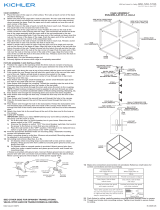 Kichler Lighting 42526OZ Manuel utilisateur
Kichler Lighting 42526OZ Manuel utilisateur
-
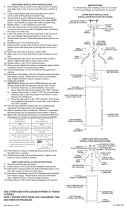 Kichler Lighting 42565BK Manuel utilisateur
Kichler Lighting 42565BK Manuel utilisateur









